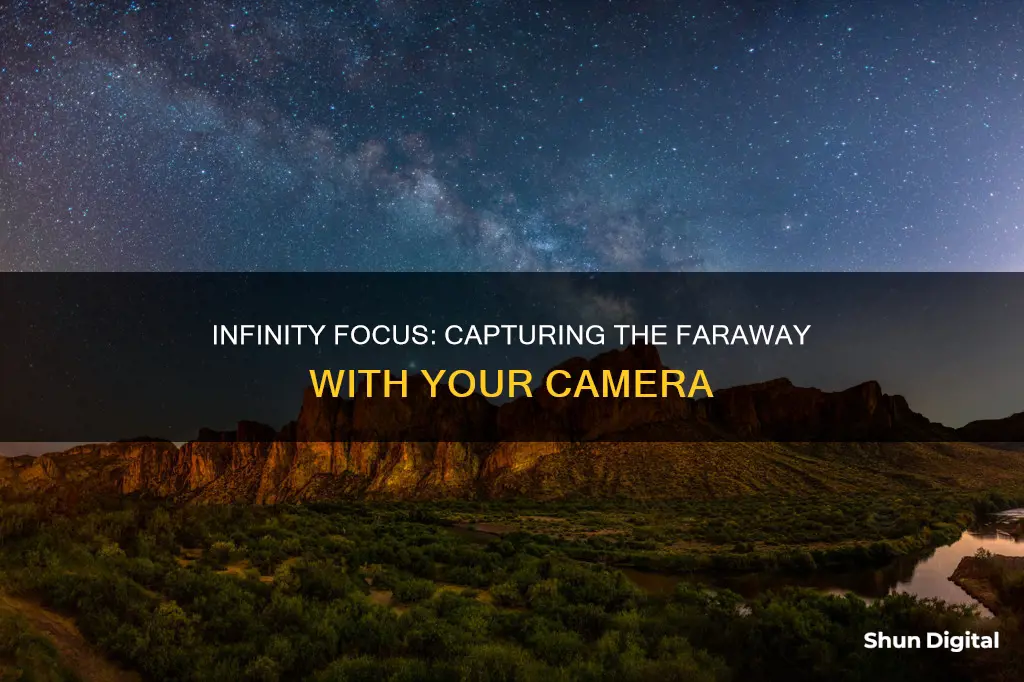
Infinity focus is a technique used in photography to bring objects at a distance into focus. Infinity focus is the opposite of a narrow depth of field. When a lens is focused to infinity, everything in the frame will be in focus, no matter the distance. Infinity focus is particularly useful for landscape photography, wildlife photography, and low-light or night-time photography.
To achieve infinity focus, photographers must first switch their lens to manual focus and locate the infinity symbol, which looks like a sideways eight. They then rotate the focus ring until it lines up with the infinity symbol. The infinity symbol may be found by rotating the focus ring all the way to the right or left. Once the infinity symbol has been located, photographers should point their lens at a distant object and rotate the focus ring until the object is in sharp focus.
It is important to note that not all lenses are capable of infinity focus, and some adapters and filters may prevent infinity focus from being achieved.
| Characteristics | Values |
|---|---|
| Definition | The state where a lens forms an image of an object an infinite distance away. |
| Focus | Everything in the frame will be in focus no matter how distant it is from the lens. |
| Use cases | Landscapes, wildlife, low light and nighttime photography. |
| Hyperfocal distance | The area between the lens and the point where everything comes into focus. |
| Limitations | Infinity focus isn't truly infinite, and some lenses and filters are not capable of infinity focus. |
What You'll Learn

Infinity focus is the opposite of a narrow depth of field
Depth of field (DoF) is the distance between the nearest and farthest objects that appear acceptably sharp in an image. The transition from sharp to unsharp is gradual, and the term 'acceptably sharp' is a loose one. The circle of confusion (CoC) is a scientific term that refers to this.
A narrow depth of field means only a small slice of the image is in focus. This is achieved by opening up your aperture, which creates a narrower area of focus and helps to isolate subjects by keeping foreground and background elements out of focus.
Infinity focus, on the other hand, is like an extraordinarily wide depth of field. It is the point at which light rays that strike the lens as collimated light are rendered as points on the image sensor. In practice, this means that objects are far enough away from your camera that the light rays coming from them are parallel.
It is important to note that infinity focus isn't truly infinite. The focal point actually starts at a distance in front of your lens, and there is an area between your lens and this point called the hyperfocal distance. Objects within the hyperfocal distance will be blurry, while everything after the focus point will be sharp. Not all lenses are capable of infinity focus, and some adapters and filters will prevent you from achieving it.
Unlocking Manual Mode: How to Identify Camera Settings
You may want to see also

Infinity focus is used for landscape photography
Infinity focus is a technique used in landscape photography to create dramatic shots with a large depth of field. It is also used to create a sense of scale and perspective in the image, and to achieve easier focusing when taking photos from a distance.
Infinity focus involves setting the camera's focus to infinity, which means that everything in the distance will be in focus, no matter how far away it is from the lens. This is similar to having an extraordinarily wide depth of field. However, infinity focus is not truly infinite. The focal point actually starts at a distance in front of the lens, and this distance is known as the hyperfocal distance. Anything within the hyperfocal distance will be blurry, while everything beyond it will be sharp.
When using infinity focus in landscape photography, it is important to ensure that no objects within the hyperfocal distance are included in the image, as they will appear blurry. This technique works best when there are strong foreground elements that lead the viewer's eye around the frame and provide a strong point of interest. It is also important to choose the right lens for infinity focus, as not all lenses are capable of achieving it. Manual focus lenses with a depth of field scale are ideal, as they allow you to line up the focus ring with the scale to achieve the proper depth of field. Autofocus lenses can also be used, but it is more difficult to achieve infinity focus with them.
Infinity focus is particularly useful in landscape photography when you want to capture all the details in the panorama, from near to far. It is also useful in wildlife photography, as it ensures that moving animals remain in focus no matter where they are in the frame. Additionally, infinity focus can be helpful in low light and nighttime photography, as it is easier to focus on distant objects that may not be clearly visible in the darkness.
By understanding and utilising infinity focus, photographers can enhance their landscape images, creating sharp and visually appealing photographs that capture the beauty of their surroundings.
Charging Your Camera: Can You Still Capture Shots?
You may want to see also

Infinity focus is useful for wildlife photography
Infinity focus is a term that can be confusing even for experienced photographers. It is the opposite of a narrow depth of field. When your lens is focused to infinity, everything in your frame will be in focus no matter how distant it is from your lens. This is especially useful for wildlife photography, where animals may be moving between the foreground and background of your shot. Infinity focus ensures that the subject is always in focus, regardless of its position in the frame.
Infinity focus is achieved by adjusting the lens to focus on an object at an infinite distance. This corresponds to the point of focus for parallel rays, with the image formed at the focal point of the lens. In practice, infinity focus is not truly infinite. The focal point actually starts at a distance in front of the lens, and there is an area between the lens and this point called the hyperfocal distance, within which objects will be blurry. The hyperfocal distance varies based on the aperture, crop factor of the camera, and length of the lens. To take effective photos at infinity focus, objects within the hyperfocal distance must be kept out of the image.
Not all lenses are capable of infinity focus, and some adapters and filters, such as macro filters, will prevent infinity focus even with a capable lens. For lenses that do support infinity focus, the method for achieving it will depend on the lens. Manual lenses with a depth of field scale can be adjusted to line up with the infinity symbol (∞). Autofocus lenses do not usually have an infinity mark, so a distant object must be selected for the lens to focus on. Once the object and everything else are in focus, the autofocus should be turned off to lock in the focus.
Infinity focus is a useful technique for wildlife photography, ensuring that moving animals remain in focus regardless of their position in the frame. It is also commonly used for landscape, low-light, and nighttime photography, where it can be challenging to focus on objects that are not easily visible.
The Ultimate Camera Companion: Understanding Battery Packs
You may want to see also

Infinity focus is helpful for low light and nighttime photography
Infinity focus is an essential technique in photography, and it is particularly helpful for low-light and nighttime photography.
Infinity focus is when a lens or optical system forms an image of an object an infinite distance away. In other words, everything in the distance will be in focus, no matter how far away it is from your lens. This is particularly useful when shooting in low-light conditions or at night, as it can be challenging to focus on objects that are difficult to see in the darkness.
When using infinity focus, it is important to remember that not all lenses are capable of achieving it. Additionally, the focal point for infinity focus actually starts at a distance in front of the lens, known as the hyperfocal distance. This distance varies depending on factors such as aperture, crop factor, and lens length. It is important to ensure that no objects within the hyperfocal distance are included in the image, as they will appear blurry.
- Use a manual-focus lens: Manual lenses typically have a depth of field scale that allows you to line up the focus ring with the infinity symbol (∞).
- Focus on a distant object: If using an autofocus lens, focus on a distant object, such as the moon or a bright star. Once everything is in clear focus, switch off the autofocus to lock in the focus.
- Use a flashlight or headlamp: If there are no bright objects to focus on, use a flashlight or headlamp to illuminate a distant object and focus on that.
- Adjust manual focus: In low-light conditions, you may need to fine-tune the focus manually. Use the Live View feature on your camera to zoom in on a bright star or planet and adjust the focus ring until the object appears as a pinpoint.
- Confirm focus: Periodically check your focus by zooming in on your photos, as it is easy to accidentally bump the lens and change the focus settings.
- Compose during daylight: If possible, arrive at your location during daylight hours and compose your shot by focusing on a distant object. Then, switch to manual focus and secure the focus ring to prevent any accidental changes.
- Focus on a distant light: If there is a bright moon or a distant light source, such as a street light or car headlights, you can use it to achieve focus.
By following these tips and practising the techniques, you can master the art of infinity focus and capture stunning low-light and nighttime photographs.
Exploring Zmodo Camera's Versatile Modes and Their Uses
You may want to see also

Infinity focus is achieved by turning the focus ring
Infinity focus is a term that can be confusing for photographers. It is often used to describe a shot with a focal point that is far away from the camera. Infinity focus is similar to an extraordinarily wide depth of field. When your lens is focused to infinity, everything in your frame will be in focus no matter how distant it is from your lens.
It is important to note that infinity focus is not truly infinite. The focal point actually starts at a distance in front of your lens, and objects within this "hyperfocal distance" will be blurry. Additionally, not all lenses are capable of infinity focus, and some adapters and filters may make it impossible even with a capable lens.
- Ensure your lens can focus to infinity. Some lenses have two focus rings that can be rotated to change the focus.
- Change your lens from autofocus (AF) to manual focus (MF).
- Rotate the smaller focus ring all the way to the right, and then to the left until the indication for infinite focus appears.
- Look through the viewfinder and adjust the bigger focus ring until the subject is in focus.
- If needed, make physical adjustments by moving closer or farther from the subject.
- If you are still unable to achieve a suitable focus, use a narrower aperture to increase the depth of field.
Achieving infinity focus can be challenging, especially when shooting at night. However, by following these steps and practicing, you will be able to master this technique and capture stunning images with everything in focus, from nearby objects to distant landscapes or astronomical objects.
Traffic Cameras in San Antonio: Tickets or Not?
You may want to see also
Frequently asked questions
Infinity focus is when a lens or optical system forms an image of an object an infinite distance away. This corresponds to the point of focus for parallel rays. In other words, when your lens is focused to infinity, everything in your frame will be in focus no matter how far away it is from your lens.
First, switch your lens to manual focus (MF). Next, turn the focus ring all the way to the right or left until you see the infinity symbol (∞). Look through your viewfinder and point your lens at an object in the distance that you want to photograph. Rotate the focus ring until the object looks sharp. If this doesn't work, try moving closer to or further from the object.
Infinity focus is useful when you want to ensure that everything in your image is in focus, from the foreground to the background. It is commonly used in landscape photography, wildlife photography, and low light or night-time photography.







